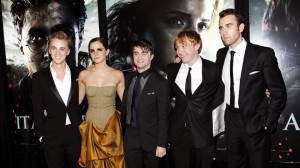‘Potter’ franchise’s finale leaves viewers with valuable thematic insights
As the final film in the Harry Potter franchise, “Harry Potter and the Deathly Hallows, 2” has a really tall order to fill: Not only should it “work” as a separate movie, but it must also tie up the principal loose ends left by the previous installments—and thematically and emotionally “sum up” what the entire decade-long viewing experience has or should have been all about.
Measured by that rigorous yardstick, the final Potter film falls short of ending up as a truly memorable and iconic production. But, despite ending up with the short end of its lead boy wizard’s magical wand, the film leaves loyal and faithful viewers with a number of valuable thematic insights that should be celebrated:
First, it makes a strong and instructive point about how, in the key protagonist-antagonist relationship between Harry and über-villain Voldemort, Good and Evil can sometimes be two faces—of the same coin!
Bountiful harvest
Also powerfully instructive is the way that Harry “forgives” some of his most bitter foes, like Draco, and even saves their lives. It later turns out that this is the unexpected key to his own final salvation, as well, as the goodness he sows, against all odds and “logic,” enables him to reap a bountiful harvest of blessings, despite his supreme enemy’s awesome powers.
Article continues after this advertisementIn addition, the story’s young protagonist is made to visibly age a lot in this final installment, as he is forced to confront—and vivify—some of life’s darkest secrets, in order to triumph over them at film’s end. He does achieve his heroic apotheosis, but it drains and ages him, sometimes seemingly beyond endurance.
Article continues after this advertisementIn communicating these three main insights, “Deathly Hallows, 2” attains heights of filmic mastery. But, it’s subsequently brought down by an overlong final battle that sadly includes a predictable “duel of the wands” between Harry and Voldemort—as well as an unnecessary, distracting and climax-diminishing “19 years later” coda about Harry’s son arriving at Hogwarts for his own schooling in the wonders and marvels of wizardry. We know that it’s been appended to enable the “dark” denouement to dovetail on a happy, optimistic note, but it’s still an excessively ingratiating ploy.
Connection
Other less than astute touches and flourishes include some deaths that are intended to raise the storytelling’s emotional and tragic quotient, but don’t work as intended, because the personages who expire haven’t been made to effect a sufficiently personal connection with viewers.
More on the plus side are the generally brisk pacing of the film’s first half, the splendid visual effects and idiosyncratic characters in its extended “underground vault” sequences, the bond fiercely sustained between Harry and his “bestest” friends, and lead star Daniel Radcliffe’s positively heroic emotional investment in his character’s torturous, tormented journey toward life-altering enlightenment.
Despite those memorable highlights, however, the production’s extended finale and coda deflect and distract from its trajectory to cinematic greatness, as the brightest jewel on the fabled film franchise’s magical diadem. In striving to be a crowd-pleaser, the last “Potter” film ends up only pleasing—the madding crowd.
